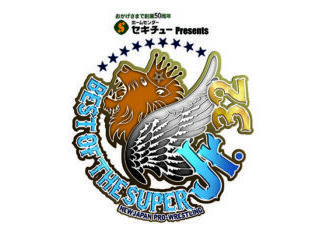
SPOTLIGHTED PODCAST ALERT (YOUR ARTICLE BEGINS A FEW INCHES DOWN)...
After initially having my interest in pro wrestling stoked by NJPW on AXS, I foolishly stepped away to give WWE a chance. I mentioned in a previous review how quickly I lost interest in WWE, which left me once again pining for NJPW to keep my interest in rediscovering pro wrestling a fruitful one. In return for my allegiance, I was welcomed back to the cool kid’s table with open arms, receiving a bounty of stellar matches on AXS to show me that I should have never left.
When I began my second tour only a few months ago, I had a preconceived notion of who were the top guys in the company. Okada, KUSHIDA, Shibata, Tanahashi, and Omega. Those were the names that I knew, and those were the names that I was going to lean on to keep me hooked. It was that preconceived notion that was shattered in spectacular fashion one night when AXS replayed Kazuchika Okada defending his title against a man I knew nothing of at the time. That man was remarkable in the ring. That man’s swagger and coolness were unlike anything I had ever seen before. That man was Tetsuya Naito.
NJPW World keeps giving and giving, generously asking for only the price of a medium quality six-pack per month in return. So far I’ve discovered gem after gem bursting from the seam of the log-in screen. It has been an enriching experience to say the least. The fact that I am ahead of my beloved AXS show is even better, though I oftentimes wonder how J.R. and Barnett are getting along. I’ll get back to those two rascals in due time, but after getting to watch New Year’s Dash and with the anticipation of New Beginning in February, I decided to keep extending my scope without them holding my hand.
Without barely even scratching the surface of all The World beholds, I came across a series of mini-documentaries called NJPW Origins – a series that aims at scratching surfaces of their own. With names SUCH AS Okada, Tanahashi, and Makabe to choose from, yet again a name stuck out. It was a documentary on Tetsuya Naito – a man who can not only shatter preconceived notions, but a man setting a new standard for the cool kid’s table.
The documentary opens with a dramatic score as Naito is shown dressed comfortably in a maroon zip-up sweatshirt, black scarf, and worn-in blue jeans. Snippets of his in-ring skills are shown to match the soundtrack that welcomes the viewer. Naito is 32 years old when this documentary was filmed in early 2015. The moment in time is captured before he became the leader of Los Ingobernables de Japon, referred to at this point as Stardust Genius.
After the music lowers and the screen fades to black, a peppier tune ques up as a camera captures Naito’s side profile as he sits behind the wheel, his eyes focused on the road as he races past a concrete wall outside the driver’s side window striped in Tarheel blue. He is asked about his best match from 2014, a question that Naito ponders as his eyes remain focused. After a moment of reflection, Naito picks his match – a NEVER Openweight title match against Ishii in Osaka. What he remembers most of that match was the atmosphere, one in which he calls amazing due to the crowd’s overwhelming booing for him.
Naito is asked about the responses he received in Sendai compared to Osaka in the space of three days. The question is met by a chuckle, which is a sight to behold. Naito’s chuckle is reserved, almost as if he is uncomfortable with how his mouth contorts to let the emotion slip out. The interviewer remarks that his response was the same as Tanahashi between 2008 and 2009.
It is revealed that two years have passed since Naito had major knee surgery. Naito admits that after two surgeries on his knee, the next one will carry severe consequences. He is nervous about it, a feeling that has prevented him from going all out in the ring.
We are taken to an overcast skyline where Naito stands outside of a gym emblazoned with the NJPW logo. It is the Noge Gymnasium – the place where Naito began his training. His first impression upon being back is that the building is far nicer than it was when he was there. As it is, the façade of the building looks more like a warehouse, its foundation walled by the type of silver corrugated sheets you’d find nailed to a roof. Reflecting on his first day at the gym, Naito talks about one of the personnel from NJPW driving him to the gym. Before he even stepped foot inside, he was met by Mr. Yoshitatsu, or Mr. Yamamoto as he was known at the time. Yoshitatsu was his dorm leader, which Naito reenacts his first impression with a sheepish grin and a shudder of excitement.
The next person that he met was “Mr. Makabe,” who upon introduction asked Naito, “What is with your hair?” Naito states that his hair was as long back then as it is today. “Mr. Makabe got angry, and thirty seconds after coming in I thought about quitting.” He says this with a much more vibrant laugh, mentioning that there weren’t any rules so he was convinced that someone was going to shave his head. Afterwards, we cut to a shot of Naito standing at a street corner holding a clear umbrella while patiently waiting for the light of a crosswalk to beckon his footsteps towards the next stop. That stop is riverside, to a separate facility where most of their training occurred.
Overlooking the facility, the interviewer asks Naito to expound on his feelings of getting to wear an NJPW shirt for the first time. Naito says that it was the first time he felt like a member. He tells of getting to go to the stadium via NJPW bus. It was at the stadium that he and the other trainees were corralled into a fenced area away from the ring where they were to watch. Although he could only watch from a fence, to him that fence meant something to him. It meant that he was a member.
As far as the camp went, he never found it tough. When asked if he ever thought about quitting, Naito allows himself to smile widely before joking that the only time the thought popped in his head was after his first encounter with Makabe. He had a motivating factor while training – the knowledge of the plan for his debut. Over the course of his time in training, Naito says that he would just repeat to himself, “Soon. It’ll be soon.”
An image of Okada pops on the screen. It is a familiar one, as The Rainmaker spreads his arms wide and looks to the sky. The interviewer asks Naito about his first impression of Okada when he joined the training dorm. Naito grins, admitting that Okada’s presence upset him at the time. When the two first met Okada was still a young teenager, his presence getting on Naito’s nerves because the tall teen didn’t have to take the entrance test to get in. He comments on Okada’s early training sessions where Okada showed off some wrestling skill, but overall lacked any type of strength to keep up with the others when it came to squats and pushups. Over time Okada earned Naito’s friendship due to him gritting it out through the training and how much he improved. “But I really couldn’t stand him at first,” remarked Naito.
An acoustic guitar plucks up-tempo notes that accompanies Naito as he travels through a compact street lined with townhomes. His destination is the Animal Hamaguchi Gym – the genesis of his journey to becoming a pro wrestler. What we find inside the building is a cramped gym littered with yellow weight machines and a dumbbell rack positioned dead center of the floor. The amount of machines create a dense forest of iron that Naito – now wearing a red Stardust Genius t-shirt and pair of white shorts – has to turn his body just to maneuver his athletic frame throughout.
He has a singular focus in his search, finally coming across an old friend that he looks excited to be reacquainted with. It is a leg press machine positioned by a floor-to-ceiling window overlooking the street, its padding reinforced by a patterned cushion snugly affixed to it. Naito lowers his body onto it and smiles. The smile is from memories; memories of dozing off in the warm afternoons in the exact same position that he mimics with arms folded and head tilted low. He smiles even wider, betraying once again the normally stoic expression that is typically etched across his face.
He hoists his body off the cushion, explaining that his job was to help others exercise when no one else was there. He explains his role while navigating towards the front desk, where he takes a seat on a stool and shows the interviewer how he’d eat his lunch before folding his arms once more and lowering them atop the desk so he could bury his head down for another nap. Naito’s attention turns to the window behind the desk where he would just stare out of unless he was reading pro wrestling magazines as opposed to working.
One of the instructors, an older squatty gentleman named Syuichi Segawa, hollers “He worked harder than he is making out, but he didn’t like having to assist members very much!” Naito laughs at the comment, admitting that he wanted to sit as much as he could. Segawa tells the interviewer that Naito was a hard worker who even helped them out when he was recovering from his knee operation. He also mentions that the owner, Mr. Hamaguchi, saw talent in Naito at a young age, though thought he was bland unless sparring.
Naito finds an old brochure from his time at the gym. He points to a shaggy-haired young man flanked by a cartoon speech bubble. That young man is himself, which Naito displays to the camera to show that he hasn’t changed much. He finds his application form, explaining that everyone had to fill one out, even guys who went on to become pros. Naito grins slyly, telling the interviewer that he would read through all of them just to see what others wrote down. On his application, written at 18 years old when he was in his third year of high school, states his purpose for wanting to train. The purpose is of a singular objective – to be in NJPW. “Fantastic,” he gushes to himself.
The screen flips to a title stating “His dream has continued on, unchanged since that day.” It is at this moment that we get shots of a young Naito dressed in a kaleidoscope of colors with dragon scales stitched along the sleeves of his jacket. While they show clips of him, the soundtrack switches to an instrumental track that is so gorgeous that I could close my eyes and get lost in 64-bit memories of traversing the plains of Hyrule. The camera cuts back to Naito in another section of the gym, his eyes scanning a ceiling beam tattooed in black Sharpie letters. The cameraman sweeps across this offshoot section of the gym, finding a tapestry of letters covering up nearly every section of the white backdrop.
Naito is asked about his reasoning for choosing the Animal Hamaguchi Gym to train. His response is simple. The gym was near his house. Naito explains that his earliest training consisted of weight lifting multiple times a week, followed by physical workouts consisting of squats and push-ups. He takes us through what a typical session would look like, standing in the middle of the large room overlooking a foam green floor. He explains that his class would form a row, with the lineup counting loudly as they churned out numerous variations of the traditional Hindu Squat. The lineup would have to climb a short rope dangled from the ceiling, each guy tasked with having to climb it twice without touching the floor on the first trip down. Next were perpendicular bars that they’d have to shimmy across before doing ten pull-ups at the end. The workout would last upwards of two hours before they broke off for grappling sessions.
Naito mentions the owner of the gym, Mr. Hamaguchi. Hamaguchi would appoint a captain to oversee the training while he sat and watched silently from a chair. Since he was a man of very little words, Naito would make sure to listen intently when he spoke, soaking in whatever his ears could take in during their intense training sessions. As the camera pans around the ceiling and walls, we are informed that the words written throughout belong to Hamaguchi, each one used to impart passion within whoever set their eyes on them while in his gym. “People cry in torment, cry in infliction, and cry again feeling emptiness in what they are doing,” Naito reads aloud from a section of the wall. “And for a moment of joy, people cry.”
The focus switches to shots of Naito interacting with kids in the crowd of a show he is wrestling on before switching to Naito back in his civvies and behind the wheel en route to the next location. The interviewer riding shotgun asks him why he values younger fans. Naito once again imparts his own wisdom, explaining that a lot of time children are brought to the venues by their parents. He wants them to enjoy wrestling because the future of pro wrestling depends on the kids who like it. His hope is that one day kids will say, “I’d like to be like Naito.” He says that wrestling is hard and painful, but in the next life he wants to come back as a wrestler.
The final stop on Naito’s trip is to the back room of a restaurant where he is shown picking through a fruit cup while waiting for his guest to join him. While waiting, he reminisces about seeing wrestling in Sapporo in July of 1999 where he watched Kojima vs. Muto for the IWGP Heavyweight title. Though his memory is hazy on who he watched on the second night, he says that it was “maybe Chono, Akira, and Onita.” He talks about possibly seeing “Mr. Tanahashi’s” first match. During that match, Naito says that he was seated in the third row, a position that was caught on camera and shown on TV for the first time. “Any fan would get excited if he finds himself on TV.” Naito explains that his father was into professional wrestling and would take him to Korakuen Hall. When asked if his father is an NJPW fan, Naito looks up from his meal and responds that his father told him to prefix Mr. to Inoki, “So he’s a NJPW fan.” He says this with a smile beaming wide across his face.
Naito’s guest arrives, which is his father, Mr. Kenichi Naito. Mr. Naito is a slender, handsome man – tailor-fit in a black suit and dark grey dress shirt underneath unbuttoned at the top. He has a debonair quality to him, his movements as smooth and fluid as his sons as he reaches for a large glass filled to the brim with the frothy foam of beer. Before taking his first sip, he tells the interviewer of a conversation he had with a young Tetsuya where he told him to be on his own at the age of twenty. “It doesn’t mean goodbye of course,” he speaks while waving his hand about. “But I had supported myself relatively early. Do everything by yourself, as it’s your life.”
Naito’s father says that he never was opposed to Tetsuya’s wish of being a pro wrestler, but was surprised by the decision. He points to his son and says, “His arms were so thin, just like mine.” Mr. Naito says that he was not a big fan of NJPW until 1980, when he became glued to Tiger Mask. He bought the most expensive Hi-Fi VCR he could find and recorded wrestling on the same tape, watching it with Tetsuya over and over.
When asked about ever seeing his son wrestle, Mr. Naito points and says that he saw his first match at Soka, where he brought his own cheering section from work with him. He breaks into laughter, leaning toward to Tetsuya to remark, “You were booed a lot in Osaka, weren’t you?” The question makes Tetsuya laugh as his father says, “It was extraordinary.” The topic turns to his son’s reception in Sendai, which Mr. Naito replies with, “In Sendai, he must be welcomed”, before giving Tetsuya a soft smack on the shoulder and telling him “I’m watching you, Kid.”
When asked who Mr. Naito is paying attention to recently, he responds with “In addition to Tetsuya Naito, I like Kota Ibushi.” Tetsuya scoffs at the answer and they break into laughter.
That striking 64-bit tone hits once more as a display on the screen states that both father and son have the same goal. Mr. Naito says that the goal is the IWGP Heavyweight title. As a father, he wants to tell his son to not get hurt and be well, but he wants to see the heavyweight title belt. Tetsuya says that every time he got a belt he would take it to his father, who he says looked so happy to wear it. Mr. Naito has only worn a tag-team title and the NEVER Openweight title. Tetsuya says that he became a pro wrestler influenced by his father, “So if he wants to see the belt, I will win and show it proudly to him!”
As the camera pans down from the ceiling to show father and son laughing together, words are branded onto the screen reading: “The origin of Tetsuya Naito: an image of his father who loves him.”
NOW CHECK OUT MORE NEW JAPAN FEATURES HERE.




Leave a Reply
You must be logged in to post a comment.